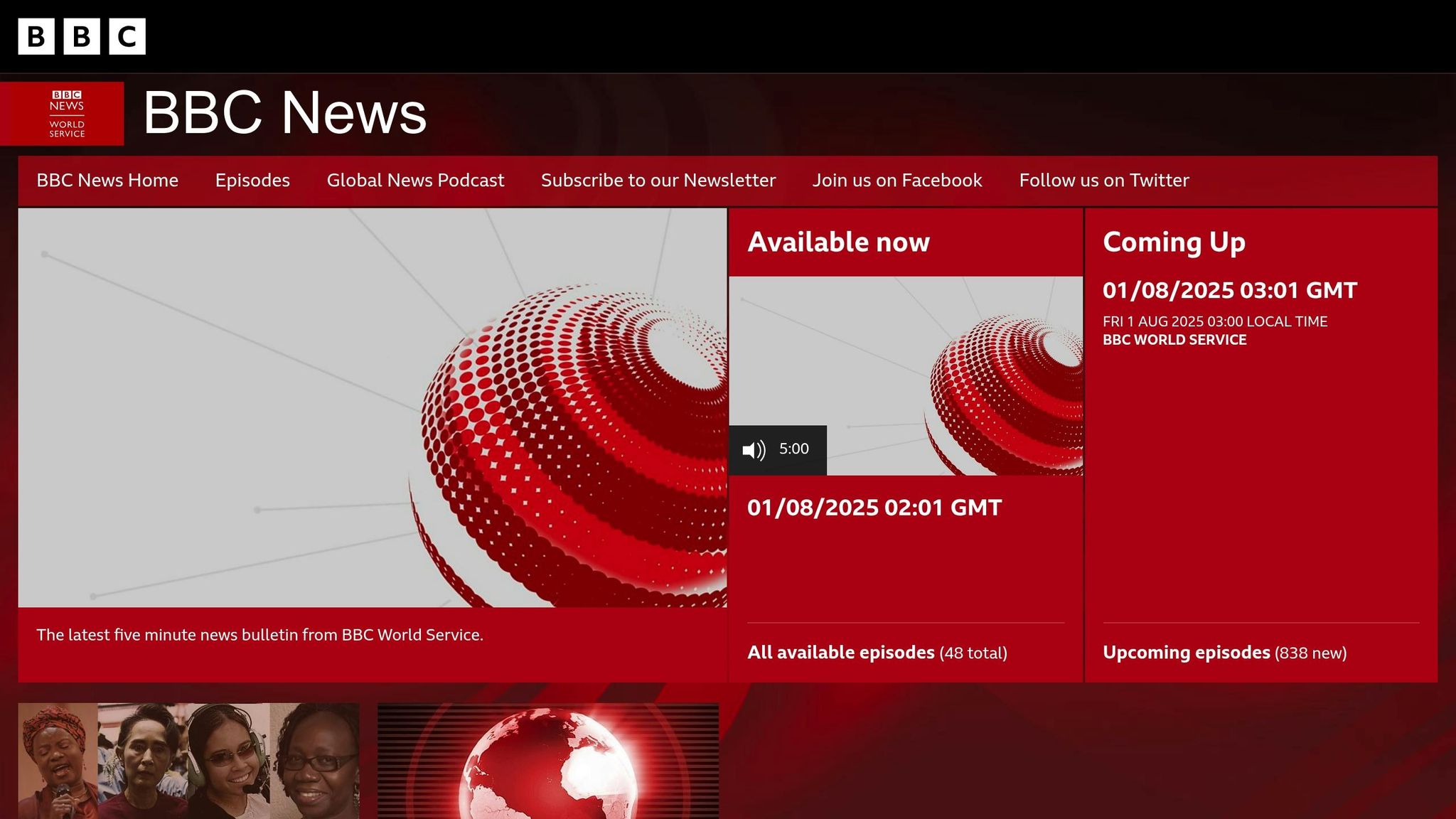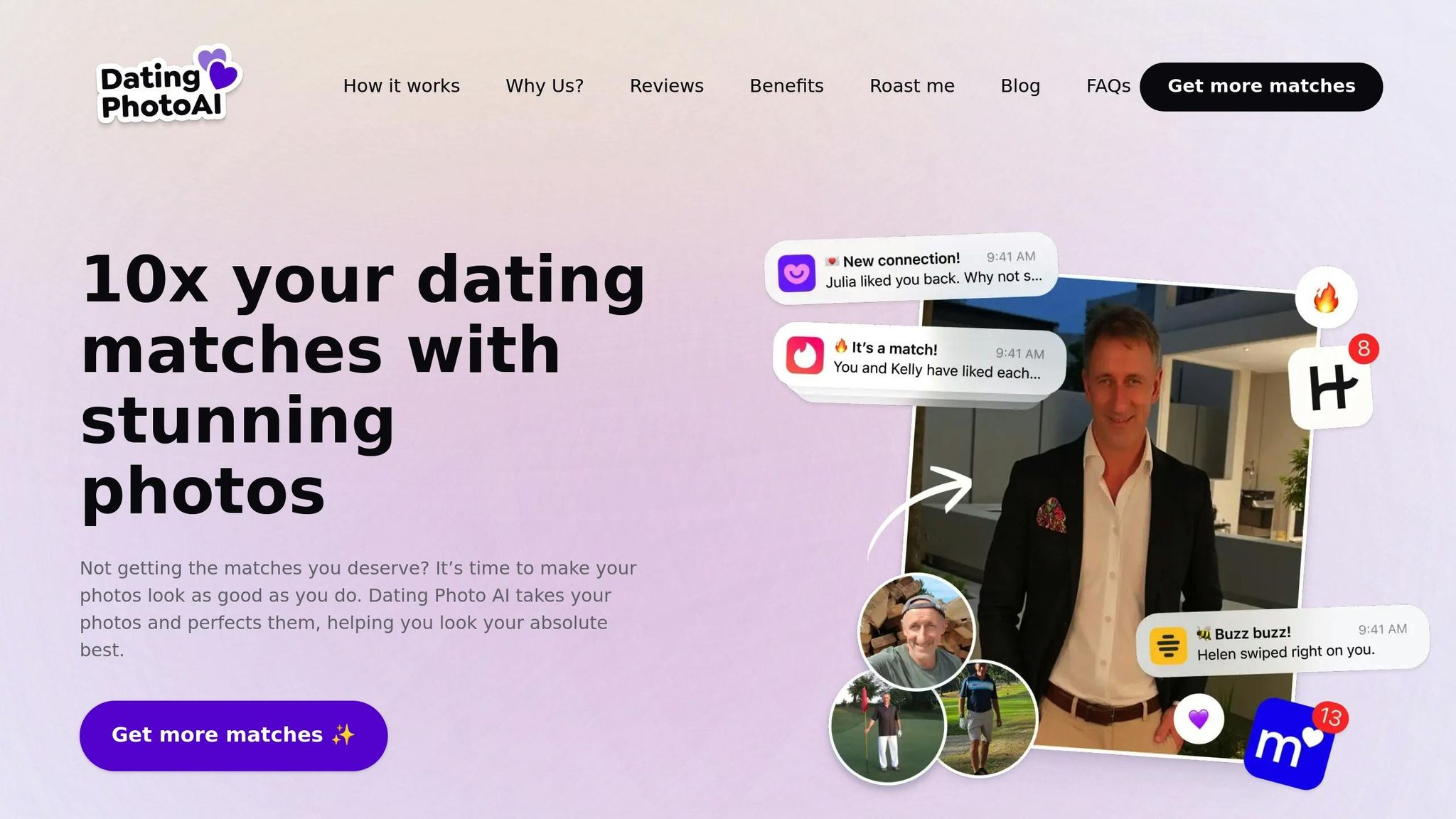
How AI Tools Analyze Match Compatibility
AI tools are transforming how people connect in the dating world, moving beyond basic filters like age or location to analyze deeper traits such as personality, communication styles, and shared values. By leveraging advanced algorithms, these tools improve match accuracy and user engagement significantly. Here's what you need to know:
- AI in Dating Apps: Platforms like Tinder, eHarmony, and Coffee Meets Bagel use AI to personalize matches based on user behavior, preferences, and even facial recognition.
- Key Data Points: AI evaluates demographics, personality traits, interests, and communication styles to predict compatibility.
- Photo Analysis: Profile photos are critical, with AI assessing factors like clarity, facial expressions, and composition to optimize matches.
- Continuous Learning: AI algorithms refine recommendations over time by tracking user interactions, such as swipes and messages.
- User Impact: Over 87% of users report improved experiences with AI-driven features, and apps using these tools see higher engagement and better match rates.
AI isn’t replacing human connection but helps users navigate modern dating more effectively by providing tailored suggestions based on meaningful data.
Can AI save dating apps? - BBC World Service

Key Data Points AI Uses for Match Analysis
AI matchmaking tools rely on a variety of data points to deliver more precise compatibility results. By analyzing extensive user data, these systems generate compatibility scores that help users find better matches. Here’s a closer look at the main categories of data that fuel these algorithms.
Demographics and Personal Information
The starting point for AI match analysis is basic demographic data. Information like age, education, location, career, and income level helps narrow down potential matches. For example, geographic proximity often plays a big role since many users prefer partners who live nearby, making it easier to align lifestyles and logistics.
Personality Traits and User Behavior
AI systems go deeper by examining behavioral patterns to understand personality traits and dating preferences. Swipe habits, for instance, can reveal what users find attractive, while messaging behavior sheds light on communication styles, engagement levels, and even preferred conversation topics. Someone who sends detailed, thoughtful messages might be matched with a person who values meaningful discussions, while users who prefer quick, frequent exchanges could be paired with others who share that communication style.
"AI dating apps enable the analysis of a wide array of user data (interests, behavioral patterns, and preferences) to build more profound and accurate matchmaking models." - Nancy Bhargava, IT consulting professional, Arka Softwares [1]
Interests and Communication Preferences
Shared hobbies and interests add another layer to compatibility. AI systems analyze profile details - like favorite music, travel destinations, or leisure activities - to find common ground between users.
Communication style is another critical factor. Natural Language Processing (NLP) doesn’t just look at what users say but also how they say it. This includes evaluating sentiment, vocabulary, humor, and emotional tone to match people with similar ways of expressing themselves.
Timing and messaging habits also matter. AI tracks whether someone prefers long, detailed conversations or quick, casual exchanges. It even considers how quickly users respond, whether they initiate conversations, and how often they engage, ensuring matches align on these subtle but important preferences.
How AI Algorithms Calculate Compatibility
After gathering user data, AI algorithms step in to predict compatibility by analyzing complex datasets. These systems use a combination of advanced techniques to deliver tailored match recommendations.
Machine Learning for Personality Matching
Machine learning is the driving force behind today's compatibility analysis. It works by identifying patterns in user data to suggest potential matches. A key method here is collaborative filtering, which examines the behaviors and preferences of users with similar interests to make recommendations [4].
Earlier platforms like eHarmony and OkCupid laid the groundwork with their compatibility tests and match percentage systems.
"The theoretical perspective underlying the online matchmaking paradigm is that who you are and who you choose to be with will have an enormous impact on the quality of your marriage."
– Steven Carter and Galen Buckwalter, eHarmony [4]
Some dating platforms take a different approach by using systems like the Elo rating to assess user desirability, pairing individuals within similar "leagues." Others, like Hinge, rely on the Gale-Shapley algorithm, which focuses on creating matches where no two people would prefer each other over their current partners. This ensures a stable and mutually satisfying match [4].
But compatibility isn't just about numbers. AI also dives deeper into communication styles to refine its recommendations.
Natural Language Processing (NLP)
Natural Language Processing (NLP) takes compatibility analysis to the next level by evaluating how users express themselves. Instead of relying solely on demographic data, NLP algorithms analyze text in user bios and messages to uncover insights about personality traits, communication styles, and shared values [5].
For example, Google's BERT algorithm introduced a 10% improvement in contextual understanding, leading to more accurate interpretations of user input [6]. In the dating world, this means NLP can identify subtle cues in language that reveal emotional intelligence and compatibility.
User Interaction Tracking and Algorithm Improvement
AI systems don’t just stop at initial recommendations - they’re constantly learning. By tracking user behavior, such as swipes, profile views, and messaging activity, algorithms refine their suggestions over time [3].
Apps like Tinder and Hinge use this feedback loop to adapt to evolving user preferences. For instance, if a user consistently interacts with a certain type of profile, the algorithm takes note and adjusts future recommendations accordingly [1] [7].
This dynamic process has delivered noticeable results. Dating platforms with AI-driven features report up to a 14% increase in user engagement, and surveys show that more than 87% of users believe AI improves their online dating experience [2].
sbb-itb-06ba92c
How Profile Photos Affect AI Matchmaking
In the world of modern dating apps, where algorithms guide potential matches, profile photos play a pivotal role. These apps rely on advanced AI to analyze not only personality traits but also the visual aspects of a user's profile. Since dating platforms are highly visual, first impressions happen in the blink of an eye - literally. The quality of your profile photo can make or break your chances of finding a match.
How Visual Elements Influence Compatibility Scores
AI doesn't just look at a photo's aesthetics - it dives deep into specific visual elements that impact how effective a profile is. According to research, users spend an average of just 2.7 seconds on a dating profile, and a whopping 84% of that time is focused on the photos [9]. Even more striking, a 2024 study revealed that decisions about swiping are often made in just 0.3 seconds based on the primary profile photo [9].
To streamline this process, AI systems use advanced face detection technology. These systems normalize face crops to adjust for angled selfies and can even analyze existing photos for recognizable faces without requiring users to upload new ones [8]. Tinder, for instance, developed a method called BasePhotoInference, which scans profile photos for a single, clearly identifiable face within a suitable frame, reducing friction in the user experience [8].
The AI also evaluates factors like facial expressions, lighting, clarity, and photo composition. Smiling, for example, makes a big difference - profiles with smiling photos receive 14% more right swipes than those with serious expressions [9]. Additionally, AI moderation tools ensure safety by filtering out inappropriate images [8].
These insights highlight the importance of creating polished, engaging profile photos that align with AI's analytical criteria.
Creating Better Profiles with Dating Photo AI

Many users struggle to upload photos that work well with AI-driven matchmaking systems. Often, they upload just one or two casual images, which limits their chances of success [8]. Dating Photo AI steps in to solve this problem by generating high-quality, realistic profile photos designed to improve match rates - sometimes by as much as 10x - across various dating platforms.
The numbers speak volumes. Professional-quality photos can boost matches by up to 178% compared to casual selfies [9]. Adding a full-body photo can increase match rates by 203%, and profiles with 4–6 high-quality, diverse images see 38% more matches than those with only 1–3 photos [9].
"Your profile picture is your handshake – it's how you introduce yourself to others." - eHarmony [9]
Dating Photo AI offers flexible plans to meet different needs. The Starter plan includes 40 photos, the Dater plan offers 80, and the Casanova plan provides unlimited photos with custom prompts. These options allow users to create a well-rounded portfolio of images that perform well with AI algorithms.
Using Dating Photo AI with AI-Powered Dating Apps
Once users have optimized their profile photos with Dating Photo AI, they can see noticeable improvements on AI-powered dating platforms. High-quality images make it easier for AI systems to analyze and process profiles accurately. Clear, well-lit photos help algorithms perform better at facial recognition and compatibility scoring.
"Make sure you're front and center in dating profile pictures. Make sure people know what you look like right from the get-go." - eHarmony [9]
The impact is undeniable: over 90% of swiping decisions are based solely on profile pictures [9], and profiles featuring optimized photos can receive up to 5x more matches [9].
Striking the right balance between authenticity and AI optimization is key. Dating Photo AI excels at creating photos that look genuine while meeting the technical standards required by matchmaking algorithms. This ensures that matches are based on real compatibility, not just superficial traits, giving users a better shot at meaningful connections.
Using AI Tools for Better Dating Results
AI is reshaping the dating landscape with its ability to streamline and enhance the matchmaking process. The numbers speak for themselves: 26% of singles are now using AI in their dating journey - a staggering 333% rise since 2024. Among Gen Z, nearly half have embraced AI to navigate the modern dating scene [10].
What are singles looking for? A significant 44% want AI to filter matches, while 40% are interested in optimizing their profiles [10]. Amanda Gesselman, a Kinsey psychologist and Match’s director of sex and relationship science, explains:
"AI isn't replacing intimacy. It's giving singles an edge. For a generation overwhelmed by options, tools that clarify and streamline choices are essential." [10]
The impact of AI on dating apps is undeniable. These platforms report increased engagement and a remarkable boost in mutual attraction rates - up to 40 times higher. In fact, 87% of users acknowledge the benefits AI brings to their dating experience [2] [11].
The secret lies in quality data. AI thrives when users provide accurate profile information and clear, optimized photos. Tools like Dating Photo AI help ensure profiles meet the visual and technical standards that AI systems use to assess compatibility [2]. This combination of personal input and advanced algorithms creates more effective matches.
AI doesn’t stop at matchmaking. It tackles multiple aspects of the dating process, such as identifying fake profiles, offering personalized conversation starters, breaking language barriers with real-time translations, and even suggesting virtual date ideas for long-distance connections [2].
What’s more, AI learns as you go. By analyzing your swipes, messages, and interactions, it refines its understanding of your preferences, improving the quality of matches over time [1]. The longer you use it, the better it gets at predicting compatibility.
At its core, AI is a tool to turn data into meaningful connections. It’s not a substitute for genuine human interaction but a partner that helps you navigate the complexities of modern dating. To make the most of it, focus on creating a profile that reflects your true self - your interests, goals, and personality. Use AI-powered features to fine-tune your approach, always keeping in mind that the technology exists to support real, human connections. After all, authentic relationships remain the ultimate goal.
FAQs
How do AI tools use Natural Language Processing (NLP) to enhance match compatibility on dating apps?
AI tools use Natural Language Processing (NLP) to dive deep into text data from user profiles and messages. By analyzing language patterns, interests, and how people communicate, NLP picks up on subtle compatibility signals that aren’t always obvious at first glance.
This deeper level of analysis connects users based on shared values, personality traits, and how they interact in conversations. The result? Matches that feel more natural and align with individual communication styles, boosting both the quality of connections and overall user satisfaction.
How do profile photos impact AI matchmaking, and how can you improve yours for better results?
Profile photos play a key role in AI-driven matchmaking. They set the tone for first impressions and help algorithms evaluate compatibility by analyzing features and personality hints. The better the quality and authenticity of your images, the more effectively these tools can work to suggest matches.
For the best results, stick to clear, well-lit photos that focus on your face from various angles and capture genuine expressions. Skip heavy filters or overly posed shots - natural, unedited images tend to connect better with both AI systems and potential matches. By keeping your photos real and relatable, you can boost your chances of finding meaningful connections.
How does AI improve its matchmaking recommendations over time?
AI enhances its matchmaking recommendations by leveraging machine learning algorithms to dive deep into user interactions, preferences, and feedback. By analyzing patterns - like which matches lead to success or how users interact with the platform - it fine-tunes its suggestions to better align with individual needs.
As the system gathers more data, it gets smarter at pinpointing personalized matches. It learns continuously from fresh user input, emerging trends, and outcomes, ensuring its recommendations remain precise and relevant over time.
